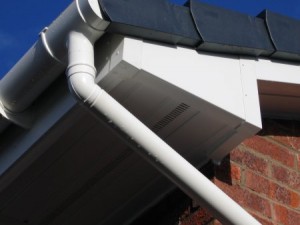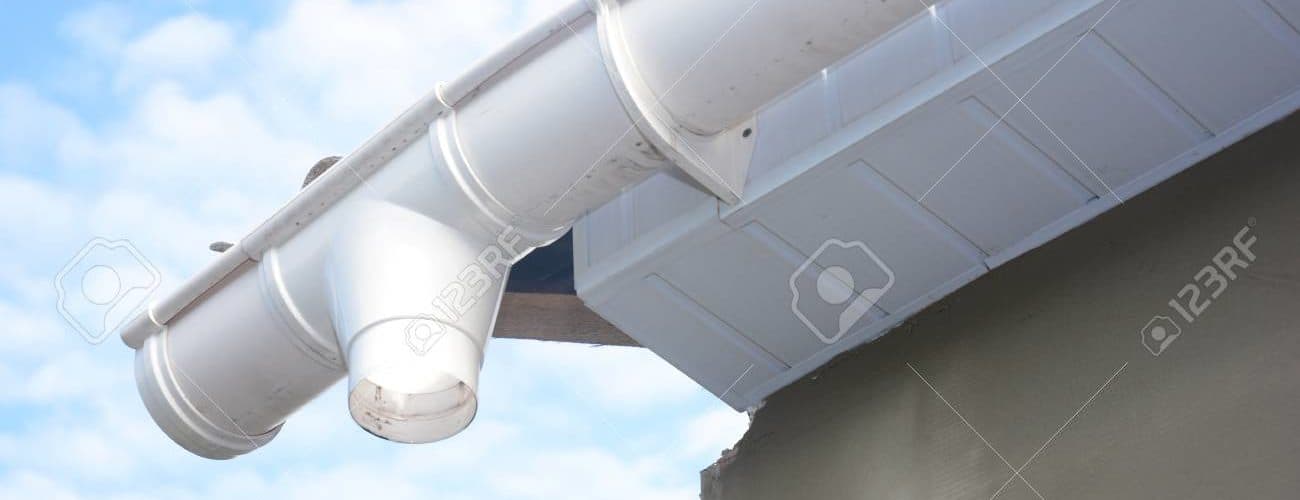Guttering along your home’s roof line is a necessary addition to protect your home and its structural integrity. Gutters capture the rain water that rolls off the roof and along with a down spout, channel it away from your home.
In official terms, rain gutters is known as a home’s rainwater management system. In addition to channeling the water away from the home, gutters help prevent the growth of mold and mildew, the destruction of landscape, backsplash of dirt and debris onto the house, basement leaks, damage to decks, and they help keep people from walking through streams of water pouring off the roof when entering and exiting the home during a rain storm.
It’s important to keep rain gutters in good repair and clean of debris that could cause the gutter to clog. When a rain water gutter clogs, you may as well not have gutters at all because the water will not be diverted away from the house and can cause the same problems that not having seamless gutters would cause. In addition, gutters that are clogged with debris are breeding grounds for mold and mildew and can attract mosquitoes as well as other unwanted pests.

Types of Rain Gutters
Roof guttering is available in a wide variety of materials ranging from vinyl to stainless steel. Each material has benefits and drawbacks.
1. Vinyl is a very popular rain gutter material and is also the most inexpensive option with a final cost of just $3 to $5 per linear foot, which includes installation. Vinyl gutters are relatively easy for a do-it-yourselfer to install and they hold their original color well because the color is integrated into the vinyl itself. In addition, they don’t rust and they are resistant to dents. The biggest drawback is that in areas of extreme cold, vinyl guttering systems can become brittle and crack.
2. Aluminum guttering is another commonly used material for gutters on roofs. It is only slightly more expensive than vinyl with final cost of $4 to $8 per linear foot, installed. Aluminum rain gutters are the type of guttering material most used with seamless gutter systems; and although it can easily dent, the color weathers well because it is baked onto the aluminum when the gutters are manufactured.
3. Higher-end rain guttering materials include copper, galvanized steel and stainless steel. While these materials are considerably more expensive at up to $20 per linear foot, they are very attractive and add a custom touch to the home.
4. Wood is also used for house guttering systems, however it is usually used for restoration projects to keep the home as true as possible to its original construction.
Rain Guttering Size Matters
Gutters are available in a number of different shapes and sizes, which are referred to as the gutter’s profile. U- and K-shaped gutters are the most common. More important than shape however, is size of both the roof gutter and downspout. In areas that receive a lot of rain, installing a larger sized gutter is a good idea because it will be better able to handle the water volume.
Sectional versus Seamless Rain Gutter Systems
Guttering systems can consist of a number of co-joined sections or they can be seamless. Sectional rain gutters are quite often used for do-it-yourself jobs because they can be easily configured and installed with tools that are readily available.
Seamless rain gutters are by far the most popular option. In fact, up to 75 percent of all gutters installed in the United States today are the seamless variety. Also known as continuous rain gutters, one of the biggest advantages of seamless gutter systems is that there are no seams or joints that can leak. The only joints are at the inside and outside corners as well as at the down spouts.
Seamless gutters are most often made of aluminum. However there are also copper and factory-painted steel options. Regardless of the material, seamless guttering cannot be installed by do-it-yourselfers because the gutters are actually formed onsite using a machine that the gutter contractor you hire brings to your home.
Related Posts



